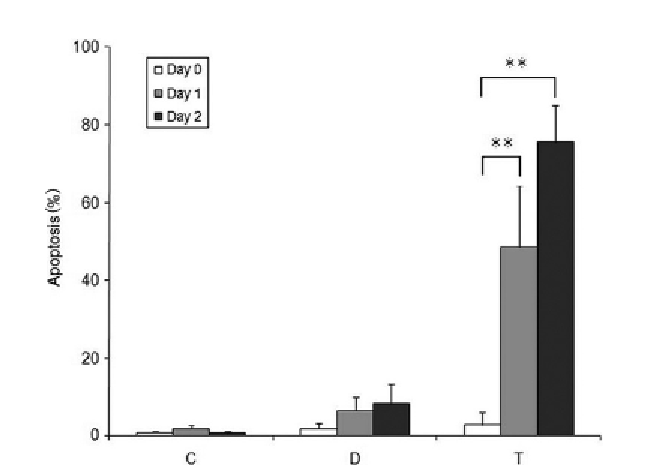Biology Reference
In-Depth Information
Figure 5.4 Cells were plated as a confluent monolayer (C), lifted as a coherent sheet
using dispase (D), or trypsinized (T), and assayed for apoptosis at 0, 1, or 2 days post-
treatment. Dispase-dissociated cells maintained cell-cell, but not cell-substrate contact,
and exhibited similar survival rates as control cells. In contrast, trypsinized cells, which
had neither cell-cell nor cell-substrate contact, underwent significantly elevated apo-
ptosis. Thus, cell-cell contact by itself is sufficient for maintaining cellular viability
(
**
p
<
0.01,
Wei et al., 2011
).
proteins may modulate cellular responses. These studies may not necessarily
have direct bearing on a particular disease or physiological process but are
illuminating for what they can reveal about the scope of junctional regula-
tion. For example, cells undergo contact inhibition (
Huttenlocher et al.,
1998
), which attenuates the migratory patterns of small clusters of cells,
and in some cases, leads to migration of an island of cells as a collective
(
Krishnan et al., 2011; Rorth, 2009
).
Research groups are also examining the specific junctional proteins
for their role in regulating cellular behavior. What is most fascinating is
that not only do these proteins affect what we may expect from their
corresponding junctional roles, but also they affect a broad range of seemingly
tangential functions. JAM-A, a molecule associated with tight junctions, reg-
ulates migratory persistence (the tendency for a cell to continue moving
in the same direction), microtubule stability, and integrin-based adhesion
(
Bazzoni et al., 2005; Huang et al., 2006
). Interestingly,
integrin-based

Search WWH ::

Custom Search